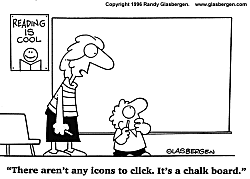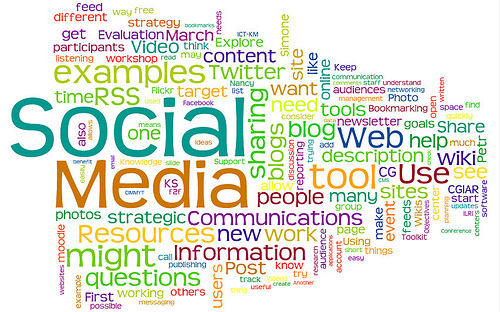Involve me, and I’ll understand: Classroom 2.0
“Tell me, and I’ll forget. Show me, and I might remember. Involve me, and I’ll understand.”
– ancient Chinese proverb
Returning to the topic I wrote about two weeks ago, I’d like to have another look at the use of technology in education. It was easy to express my annoyances about the way platforms such as Blackboard are oftentimes used, but now for the more constructive part: what can we do about it? I’d like to broaden this subject to include not just electronic learning environments, but a wider range of digital social practices that could be used in educational settings, such as chat, wikis and blogs.
Why introducing Web 2.0 into the classroom
 In discussions on technology enhanced learning (TE-learning) a big part is played by the new generation of digital natives, who have reached the age where they become a critical user of the educational system. The assumption is that their needs will no longer be met by the traditional design of that system. This was considered one of the main drives to redesign education and head towards a more Web 2.0 way of learning. This approach has recently brought up some criticism however. A strict devision between digital natives (new generation of students) and digital immigrants (teachers) is questioned, as is the assumption that the digital natives dictate the ways in which traditional systems like education or history are to be viewed.
In discussions on technology enhanced learning (TE-learning) a big part is played by the new generation of digital natives, who have reached the age where they become a critical user of the educational system. The assumption is that their needs will no longer be met by the traditional design of that system. This was considered one of the main drives to redesign education and head towards a more Web 2.0 way of learning. This approach has recently brought up some criticism however. A strict devision between digital natives (new generation of students) and digital immigrants (teachers) is questioned, as is the assumption that the digital natives dictate the ways in which traditional systems like education or history are to be viewed.
It’s an interesting discussion, but I agree with the critique that the need to take learning a digital step further does not depend on whether or not the digital divide is a demographic actuality. Even if the needs were not dictated by this new generation, the fact is that the technology is there and it keeps on evolving. If the tools are available and can enhance learning experience, then why not use them? I don’t think it is so much a matter of change being dictated by a new user group, but more as a new step in a continuous process of development.
Digital technology can either replace all physical aspects of learning, eliminating classes and other spatially determined dimensions of education, or it can be an addition to more traditional ways of teaching. Regarding the latter, I would discern roughly three aspects to successfully integrating Web 2.0 technology into the classroom. First, a Web 2.0 platform has to be usable for both students and teachers. Secondly, it isn’t always necessary nor useful to incorporate all possible means of social media. And finally, if digital means are used next to physical aspects in education, the two should be complementary and not be an element on its own.
Usability
When looking for texts and theories about TE-learning I found that they often focus of the obvious object: the student. They are the ones having to learn, they are the ones whose digital literacy counts as measure for the didactic needs. Graphic user interface (GUI) and information design have to be clear and appropriated to the needs and abilities of students. One aspect here is unjustly being left out: the teacher. Education, whether it be in physical form or digital, is still a pedagogic process, where a teacher holding certain knowledge has to transfer this knowledge onto the pupils. The vehicle for the knowledge transfer can be a book, a lecture, a blog, a wiki, but it’s primarily the quality of the input that determines the quality of the didactic process. The vehicle and the possibilities it presents come in second.
When thinking about which social media are useful in education, we shouldn’t only be considering the needs and wishes of students, but those of the ones teaching as well. They have to be just as comfortable with the technology, because they have to use it just the same.
Scale
Amid all the possibilities Web 2.0 has to offer, it easily becomes confusing which ones can be of value to a course. All these practices have their own characteristics which should be considered. Blogs are very suitable for expressing personal opinions, which can be desirable in for example art critique. Wikis on the other hand fit to the need of documenting information more permanently, that could be desirable in a field like philosophy. Twitter has a more ad-hoc quality about it and can be useful when a course concerns information that can quickly change, politics or journalism, but mathematics probably less so.
All of these, and more, technologies could be used on their own, or could be integrated in a virtual learning environment; most of those software packages already include messaging boards/forums. These packages should be scalable. It should be easy enough to in- or exclude the different modules. And the scalability shouldn’t stand in the way of usability for both students and teachers.
Integration
When digital methods are used in addition to a physical aspect it should be contemplated how the two can positively enhance one another. When hearing Anita Ondine speak about transmedial storytelling at PICNIC’10, I realized how new media and Web 2.0 are often viewed as forms of media that stand on their own. Those who study media will probably question the straightforward autonomy of the two and explore how the two interrelate, but it’s a common conception among general users of new media. Educators constructing their program to include the use of social media should take this into account.
What needs exploring
When exploring the topic of TE-learning there’s definitely lessons to learn concerning the part educators play when using information technology in the curriculum. An ethnographic approach including case studies and interviews could give them a voice in the debate. The focus should not be on theories of differences between generations, but in stead needs to be practical: what are the different needs are how can they be met. Furthermore, pedagogic, social and media studies have to find ways to chart optimum use of digital technology as an addition to face-to-face teaching. This can only be done when a joined effort is made. I believe there is enormous potential in using new media and social platforms in the classroom and good examples pop up around the world. But in order to make this work for educational institutes in general, there’s still parts of the terrain that need a closer look.
